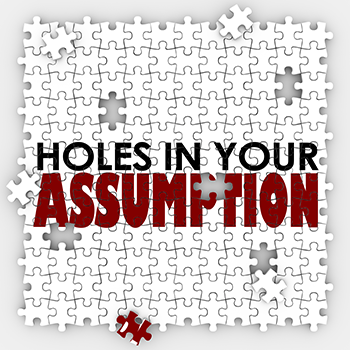 Let’s face the truth: We’re not good at evaluating ideas and theories properly. This is because we fall victim to :
Let’s face the truth: We’re not good at evaluating ideas and theories properly. This is because we fall victim to :
1. Confirmation bias. We only look for data that supports our favorite theory, so we use it like a drunk man uses a lamppost – for support, not illumination.
2. Availability bias. We tend to overvalue data that is available and ignore data that would be expensive or difficult to obtain. Here is an example:
“Our customer survey asks ‘How did you hear about us?’ and 38 percent answered ‘TV ads,’ even though we’ve never been on TV. That can’t be right, so we’ll ignore that. But now let’s look at the radio stations on which they say they heard our ads. We can trust that data.”
3. A failure to examine our assumptions.
- Ads for men’s body wash should be targeted to men, right? Wrong. Women choose the soap used by men far more often than men choose it for themselves.
- Men choose the engagement ring, right? Wrong. Women shop for their own engagement rings about 50 percent of the time. Consider these scenarios:
- “I know for a fact that our plumbing company gets more calls for water heater replacement than for any other service we offer.” Wrong. When I asked that CEO to check his records, dripping faucets was number one.
- “Our customers often comment on the quality of our service, so that’s what we should advertise, right?” Wrong. Customer service will bring repeat customers, but it is rarely the reason for a customer’s initial visit.
- “Customers often tell us how unique our selection is, so that’s what we should advertise, right?” Wrong. “Unique selection” is a hollow claim. [quotesright]It is something you must show, not tell.[/quotesright]
4. The misinterpretation of data. “The data clearly indicate that we have a much higher conversion rate when customers call our sales agents instead of going to our website. Conclusion: our ads must drive traffic to the sales agents. Numbers don’t lie.” Wrong. The data was saying, “Fix your website.”
When they got serious about upgrading their online experience, online ordering increased to the point where it is no longer the exception but is the norm and that already-large business has more than doubled its size.
Important: Data is usually accurate when describing quantities, but it is woefully inadequate when describing qualities.
Data is a snapshot of yesterday. It does not predict tomorrow.
“You can’t connect the dots looking forward. You can only connect them looking back.” - Steve Jobs
Takeaway?
If this has been interesting and enhances your understanding of how our minds can fool us into complacency and blind us to what is possible, what are you going to do differently in 2022 than you did in 2021 to improve your business?
Want to explore further?
Questions? – Get in touch and let's set up a time to talk. Brian Tracy USA: 877.433.6225